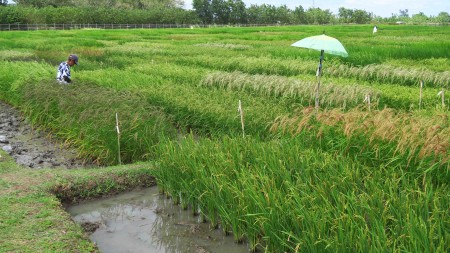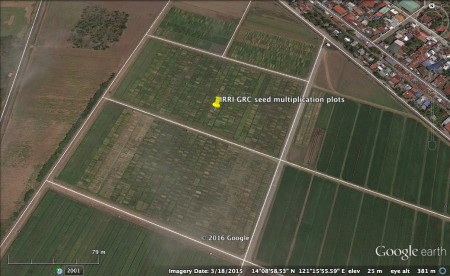- Pigeonpea breeding in eastern and southern Africa: challenges and opportunities. No longer orphan, but then again not exactly adopted yet.
- Genetic diversity in the rice landraces (Oryza sativa L.) of coastal Sundarbans (India) and their adaptation to the local saline condition investigated both at molecular and physiological level. Out of 50 landraces, three have salinity tolerance genes that have not already been used.
- Review of shrubs and trees in intensive ruminant systems in temperate areas. Promising, but not as common or easy as you might think.
- A Phaseolus vulgaris Diversity Panel for Andean Bean Improvement. Andean diversity assessed for Africa.
- Developmental Peculiarities and Seed-Borne Endophytes in Quinoa: Omnipresent, Robust Bacilli Contribute to Plant Fitness. Next step, try them on other crops. What could possibly go wrong?
Multiplying rice
Speaking of genebank multiplication plots, I’m told this is the best time of year to stroll through rice ones, and get an idea of the diversity on display. Here’s the evidence, courtesy of our friends at IRRI.

The genebank tries to alternate early- and late-maturing varieties when regenerating accessions, as you can clearly see from this Google Earth shot from March last year, half way through the harvest (the coordinates are 14.15°N 121.26°E, in case you want to check for yourself, and here’s the kmz file).

Meanwhile, the Nordic genebank is struggling with its multiplication.
Nibbles: Solutions edition
- No new salinity tolerance in cereals? You need to look at the right thing.
- No new crops? Focus on plants’ sex lives.
- No hope for drylands? Look to biodiversity.
- No new agricultural land? No problem.
- No data on neglected Himalayan crops? Got you covered.
- No way you’re drinking coffee from civet droppings? Chemistry to the rescue.
- No place for the offspring of F1 hybrids in your agriculture? Go apomictic.
- No new fruits left to try? Hang in there.
- No diversity in your Aragonese homegarden? There’s a genebank for that.
- No impact for your agricultural research. Try clusters.
- No agroecological patterning to your crop’s genetic diversity? It’s the culture, stupid.
Brainfood: Animal genomics, Konjac diversity, New wild cassava, New wild cowpeas, Saline breeding, Land sparing, Sorghum diversity
- The impact of whole genome sequence data to prioritise animals for genetic diversity conservation. Relationships from whole genome sequence data were better than SNPs at preserving rare variants when selecting individuals for inclusion in a genebank.
- Genetic variation in wild populations of the tuber crop Amorphophallus konjac (Araceae) in central China as revealed by AFLP markers. Diverse, endangered, somewhat isolated populations, with some geographic structuring.
- Manihot allemii sp. nov. (Euphorbiaceae s.s.) with entire and unlobed leaves from northern Brazil, with notes about foliar anatomy. It never ends.
- Novel Genetic Resources in the Genus Vigna Unveiled from Gene Bank Accessions. Japan sorts out its genebank. It really does never end.
- Uncoupling of sodium and chloride to assist breeding for salinity tolerance in crops. We’ve been breeding for exclusion of Na+, but we should be breeding for tolerance to it.
- How can higher-yield farming help to spare nature? By making sure that lower prices and/or higher profits don’t encourage agricultural expansion.
- Seed exchange networks, ethnicity, and sorghum diversity. Culture drives diversity.
Brainfood: Lima bean cyanide, Hybrid powdery mildew, Amaranth core, Cotton core, Tibetan sheep, Water buffalo history
- Herbivore damage induces a transgenerational increase of cyanogenesis in wild lima bean (Phaseolus lunatus). Lamarck lives.
- Hybridization of powdery mildew strains gives rise to pathogens on novel agricultural crop species. Hybrid crop gives rise to hybrid pathogen.
- Trait-specific Amaranth Germplasm—Potentialities to Combat Climate Change. From 5,804 accessions to 623 really useful ones.
- Genetic diversity of the two commercial tetraploid cotton species in the Gossypium Diversity Reference Set. 100 SSRs on 2000 accessions yield really confusing results.
- Genetic diversity estimates point to immediate efforts for conserving the endangered Tibetan sheep of India. Only 250 individuals, but still some genetic diversity. But for how long?
- Water Buffalo Genomic Diversity and Post-Domestication Migration Routes. Two domestications, and some unexpected migration routes.